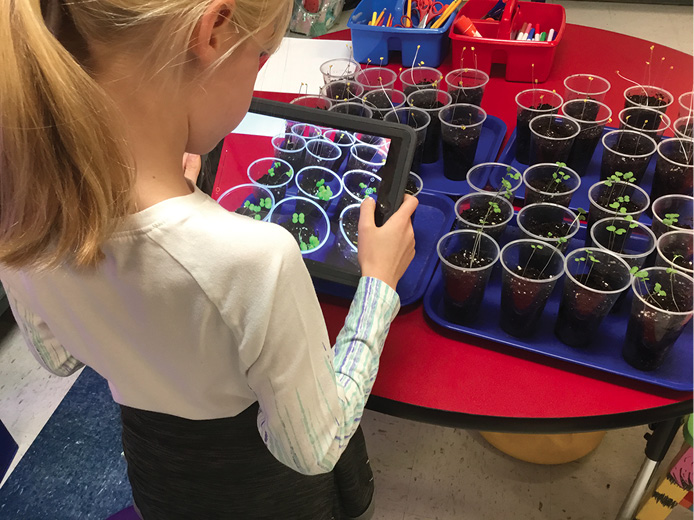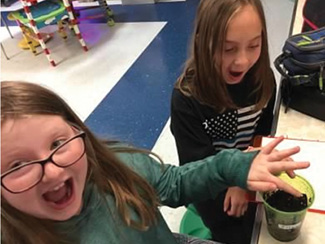Start With Phenomena
Growing With Phenomenon
Plant investigations pique curiosity and wonder
Science and Children—May/June 2022 (Volume 59, Issue 5)
By Tiffany Pace
My third-grade class began our plant investigations by taking a walk around our school. As we walked, I posed the question, “Do plants know we are here?” My students looked at me like I was crazy. “Plants aren’t alive, so they don’t feel like we do,” one student commented. “They are alive,” another student stated, “but I don’t know if they feel.” “I don’t think the tree really knows I’m standing beside it,” a student said. Once inside the classroom, I posed the question again, “Do plants know we are here?” The goal of this broad question was for students to understand plants are living entities affected by our actions.

To find the answer to our question, each student planted three Mimosa pudica seeds, also known as the touch fern, into a cup filled with potting soil. I kept the name of the plant a secret from my students in order to maximize their reaction and understanding later. For two months, the plants were cared for in our classroom greenhouse under ultraviolet light while students learned about the lifecycles of plants and insects. During this time, students compared and contrasted a plant’s life cycle to that of an insect’s.
After the second set of leaves had grown on each student’s plant, I posed the question again, “Do plants know that we are here?” and reviewed my students’ predictions. Many thought plants might know we are here but thought there wasn’t a way to know for sure. I called groups of students to the table and asked them to touch their plants. They were speechless as their plants coiled up at their touch. “It knows I touched it!” and “I can’t wait to show my parents!” students exclaimed. Because it was October, my students made the connection to how a pumpkin’s tendrils find something to hold onto, another response to touch. We also watched a video on the Venus flytrap, exposing my students to carnivorous plants and how they use touch. I then asked my students, “If plants can respond to us, what can this teach us?” My students discussed how we should be kind to plants and to stop using so many chemicals that might affect them.
Gardening Without Soil
Now that I had their attention, it was time for our second investigation. Through their observations, students believed all plants grew in soil, so I asked, “Can plants grow without soil?” Again, my students looked at me like I was crazy. “How could a plant grow if it didn’t have soil? It would die!” one student stated. Our next investigation explored the phenomenon of hydroponics.
To begin, we placed two mint seeds each on eight sponges and placed the sponges into a small container of water. Each day my students observed the seeds and, at first, they told me their predictions had to be correct because nothing was happening. Then the seeds began to grow, but my students were still skeptical. “They’re growing, but they won’t last because they don’t have dirt.” After the plants were approximately one-inch tall (three weeks later), we placed the sponges into holding trays and placed the trays into the hydroponic unit. We added water to the unit and I added a liquid nutrient solution. “What’s that?” a student wondered. I explained the bottles contained nutrients. “So, is that like their vitamins?” a student asked. We compared the nutrients to the vitamins and minerals they need to grow. Still, my students had not made the connection that plants do not need soil but the nutrients within soil to grow.

Approximately three more weeks went by and the plants continued to grow. “How are they growing?” one student asked. I reviewed how the plants have light (from ultraviolet light), air, and nutrients, and I waited. “But they still don’t have dirt,” one student stated. “Wait! So, dirt doesn’t make a plant grow?” another asked. “Could the dirt hold the nutrients?” I posed. My students quickly realized plants need nutrients to grow, not just dirt. Playing upon their curiosities and questions, I showed them a video on hydroponics. My students began discussing their newfound knowledge and linked it to real-world examples such as using hydroponics for people who live in apartments and do not have land to grow a garden outside.
But the fun didn’t stop there. My students were amazed the plants smelled like mint and quickly realized mint comes from a plant! Using an infusion pitcher, we placed the mint inside, added water, and made mint water.
Students asked, “What else can we grow?” and our next hydroponic endeavor was to plant basil, oregano, and garlic chives. My students were amazed at how different the seeds were from the tiny oregano seeds to the larger garlic chive seeds. “Will the plants look different too?” one student asked. I told them we will have to observe the plants and see. After approximately one month, my students were able to compare and contrast the differences in the physical characteristics of the herbs while realizing the life cycles were similar. We then used most of these herbs to top “muffin pizzas” while keeping some of the plants to allow them to flower and then go to seed. I wanted my students to make the connection that the smells and tastes of herbs come from plants they can grow. When using herbs in drinks and on food, please be aware of any food allergies and proper food handling practices such as hand washing.
Observing Plant Growth
For over three months my students observed various plant life cycles and could identify a healthy plant based upon color (green) and how the stem stands upright as well as how plants can grow in various conditions. Using this information, our third investigation posed the question of whether or not plants could grow without light, helping them to understand cause and effect within science. According to the National Research Council, “Students at any grade level should be able to ask questions of each other about the texts they read, the features of phenomena they observe, and the conclusions they draw from their models or scientific investigations … In the elementary years, students’ experiences should be structured to help them learn to define the features to be investigated” (NRC 2012, p. 56).
Students made predictions of how the absence of light would affect plant growth, such as that plants in the dark would turn black or would die. Because we only had one small hydroponic unit and therefore could not test the number of plants needed, we decided to plant the seeds in soil. Each student planted three Wisconsin Fast Plants seeds each in two cups of potting soil (one for light and one for dark.) Make sure students wash hands after handling soil.
We placed the light plants in our classroom greenhouse and the dark plants in a filing cabinet. We watered both groups with the same amount of water every other day. Over the course of approximately two weeks, students took photographs of both sets of plants on given days and recorded their observations. At the end of the two weeks, students reviewed their predictions and discussed if their predictions were correct, recording their conclusions in Keynote presentations. For the Keynote presentations, each student had to create at least six slides, consisting of the title; brief explanation including predictions; photographs and observations for days 1, 3, and 8; and a conclusion statement of whether or not their prediction was correct with examples to support the statement. The purpose of the presentations was to help students learn how to record data from an investigation and then to share their findings. Keynotes were assessed according to a rubric.
Many students were shocked to find the plants that were placed in the dark did grow, just slower and the plants did not appear as “strong.” When asked to explain “strong” they commented the stems were thinner and most of the plants were leaning over instead of standing straight compared to the thick, green, erect stems of the plants placed in the light. As another formative assessment, students were given an exit ticket asking them to share what they learned from the investigation. Most commented they learned plants need light in order to grow properly.
We continued to monitor the plants for a few more weeks to allow the plants to flower, be pollinated (using cotton swabs), and then go to seed. The plants in the light were able to complete the life cycle versus the plants in the dark, which slowly died.
Conclusion
These plant phenomena investigations helped my students engage in learning about plant lifecycles while looking at their world through the lens of a scientist. They began to ask more questions such as, “Why does that happen?” “Are there more plants that are different?” and “If we did this, would … happen?” Through these investigations my students were able to use their curiosities and observation to deepen conceptual knowledge while building bridges to their next scientific endeavors. ●
Online Resources
Hydroponics and Robotics: https://www.pbs.org/video/feb-28-2019-hydroponics-and-robotics-ruxukt
The Venus Flytrap: https://www.pbs.org/video/plants-behaving-badly-venus-flytrap
Tiffany Pace (tpace@mail.kana.k12.wv.us) is a third-grade teacher at Weberwood Elementary in Charleston, West Virginia.


